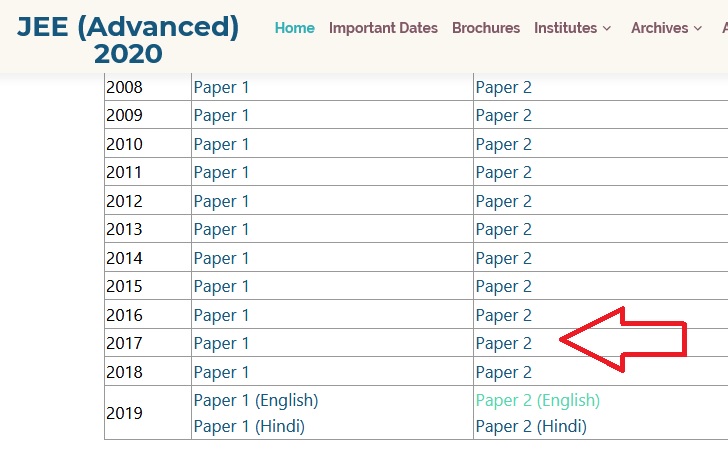jeeadv.ac.in JEE Advanced Previous Question Paper 2019 : Indian Institutes of Technology
Name of the Institute : Indian Institutes of Technology
Name of the Examination : JEE (Advanced)
Subject : Physics/ Chemistry/ Mathematics
Document Type : Previous Question Paper
Year : 2019
Website : https://jeeadv.ac.in/
JEE Advanced Previous Question Paper
Download Question Paper of JEE (Advanced) 2019 Sample Question Paper is now available in the official website of Indian Institutes of Technology.
Related : Indian Institutes of Technology JEE Advanced Question Paper 2016 : www.pdfquestion.in/11019.html
Instruction
Maximum Marks : 15
** This section contains FIVE questions.
** Each question has FOUR options (A), (B), (C) and (D). ONLY ONE of these four options is correct.
** For each question, darken the bubble corresponding to the correct option in the ORS,

Physics
Download Question Paper :
Paper – I :
https://www.pdfquestion.in/uploads/pdf2019/34462-jeeadv1.pdf
Paper – II :
https://www.pdfquestion.in/uploads/pdf2019/34462-jeead2.pdf
Section – I
Q.1 Consider a spherical gaseous cloud of mass density pr) in free space where r is the radial distance from its center. The gaseous cloud is made of particles of equal mass m moving in circular orbits about the common center with the same kinetic energy K. The force acting on the particles is their mutual gravitational force. If pr) is constant in time, the particle number density n(r) = p )/m is [G is universal gravitational constant
2. A thin spherical insulating shell of radius R carries a uniformly distributed charge such that the potential at its surface is V. A hole with a small area a4nR? (a < 1) is made on the shell without affecting the rest of the shell. Which one of the following statements is correct?
(A) The potential at the center of the shell is reduced by 2 avo
(B) The magnitude of electric field at the center of the shell is reduced by avo
(C) The ratio of the potential at the center of the shell to that of the point at R from center towards the hole will be
(D) The magnitude of electric field at a point, located on a line passing through the hole and shell’s center, on a distance 2R from the center of the spherical shell will be reduced by
3 . A current carrying wire heats a metal rod. The wire provides a constant power (P) to the rod. The metal rod is enclosed in an insulated container. It is observed that the temperature (T) in the metal rod changes with time (t) as
4 . In a radioactive sample, 4K nuclei either decay into stable Ca nuclei with decay constant 4.5 x 10-10 per year or into stable 4. Ar nuclei with decay constant 0.5 x 10-10 per year. Given that in this sample all the stable 20Ca and 1:Ar nuclei are produced by the 19K nuclei only. In time t x 100 years, if the ratio of the sum of stable 20Ca and 13 Ar nuclei to the radioactive 49K nuclei is 99, the value of t will be, [Given: In 10 = 2.3]
Each question has FOUR options. ONE OR MORE THAN ONE of these four option(s) is(are) correct answer(s).
For each question, choose the option(s) corresponding to (all) the correct answer(s).
Answer to each question will be evaluated according to the following marking scheme
Full Marks : +4 If only (all) the correct option(s) is(are) chosen
Partial Marks :+3 If all the four options are correct but ONLY three options are chosen;
Partial Marks : +2 If three or more options are correct but ONLY two options are chosen and both of which are correct;
Partial Marks : +1 If two or more options are correct but ONLY one option is chosen and it is a correct option;
Zero Marks : 0 If none of the options is chosen (i.e. the question is unanswered);
Negative Marks : -1 In all other cases.
For example, in a question, if (A), (B) and (D) are the ONLY three options corresponding to correct answers, then choosing ONLY (A) (B) and (D) will get +4 marks choosing ONLY (A) and (B) will get +2 marks, choosing ONLY (A) and (D) will get +2 marks, choosing ONLY (B) and (D) will get +2 marks, choosing ONLY (A) will get +1 mark, choosing ONLY (B) will get +1 mark; choosing ONLY (D) will get +1 mark; choosing no option (ie the question is unanswered) will get O marks, and choosing any other combination of options will get -1 mark.
Section – II
5. A cylindrical capillary tube of 0.2 mm radius is made by joining two capillaries T1 and T2 of different materials having water contact angles of 0° and 60°, respectively. The capillary tube is dipped vertically in water in two different configurations, case I and II as shown in figure. Which of the following option(s) is(are) correct?
Surface tension of water = 0.075 N/m, density of water = 1000 kg/m”, take g = 10 m/s21
(A) The correction in the height of water column raised in the tube, due to weight of water contained in the meniscus, will be different for both cases.
(B) For case II, if the capillary joint is 5 cm above the water surface, the height of water column raised in the tube will be 3.75 cm. (Neglect the weight of the water in the meniscus)
(C) For case I, if the joint is kept at 8 cm above the water surface, the height of water column in the tube will be 7.5 cm. (Neglect the weight of the water in the meniscus) the capillary joint is 5 cm above the water surface, the height of water column raised in the tube will be more than 8.75 cm. (Neglect the weight of the water in the meniscus)